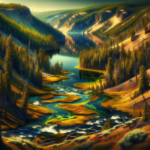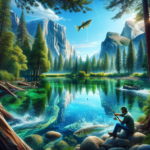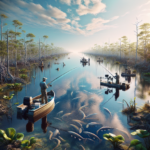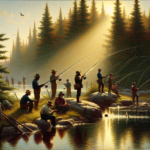Fishing in Glacier National Park: Lakes, Rivers, and Streams
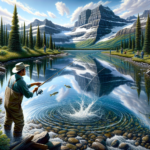
Introduction
Imagine casting your line into the crystal-clear waters of a pristine alpine lake, surrounded by towering peaks and untouched wilderness. Welcome to Glacier National Park, a fishing paradise that offers anglers a unique and unforgettable experience. Whether you’re a seasoned angler or a novice looking to try your hand at fishing, Glacier National Park has something for everyone.
In this article, we will explore the best fishing spots in Glacier National Park, the techniques you need to master, the species you can expect to catch, and the gear you’ll need. We’ll also cover important regulations, seasonal considerations, and tips to make your fishing trip safe and enjoyable. By the end of this guide, you’ll be well-prepared to embark on a fishing adventure in one of America’s most stunning national parks.
Background/Context
Historical or Cultural Significance
Glacier National Park, established in 1910, is a treasure trove of natural beauty and biodiversity. The park’s waters have been a vital resource for indigenous peoples for centuries, providing sustenance and playing a significant role in their cultural practices. Today, the park continues to be a haven for anglers, offering a chance to connect with nature and experience the thrill of fishing in a pristine environment.
Geographical Overview
Located in the northern Rocky Mountains of Montana, Glacier National Park spans over one million acres and features a diverse range of ecosystems. The park is home to more than 130 named lakes, numerous rivers, and countless streams, all teeming with fish. The climate varies from alpine to subalpine, with cold winters and mild summers, making it an ideal habitat for various fish species.
Key Points/Details
Fishing Techniques
Technique Overview
Glacier National Park offers a variety of fishing techniques to suit different preferences and skill levels. The most popular techniques include fly fishing, spin fishing, and bait fishing.
When and Where to Use
- Fly Fishing: Best suited for rivers and streams, particularly during the summer months when insect activity is high.
- Spin Fishing: Effective in both lakes and rivers, especially in deeper waters where fish tend to congregate.
- Bait Fishing: Ideal for lakes and slower-moving waters, particularly in the early morning or late evening.
Recommended Gear
- Fly Fishing: A 5-6 weight fly rod, floating line, and a variety of dry flies, nymphs, and streamers.
- Spin Fishing: A medium-action spinning rod, 6-10 lb test line, and a selection of spinners, spoons, and soft plastics.
- Bait Fishing: A light to medium-action rod, 4-8 lb test line, and live bait such as worms or artificial bait like PowerBait.
Species Information
Species Overview
Glacier National Park is home to a variety of fish species, including native and non-native species. Key species include:
- Cutthroat Trout: Native to the park, these fish are known for their distinctive red throat markings and are often found in rivers and streams.
- Rainbow Trout: A popular game fish, rainbow trout are found in both lakes and rivers and are known for their acrobatic fights.
- Brook Trout: Often found in colder, higher-elevation waters, brook trout are known for their vibrant colors and aggressive feeding habits.
- Lake Trout: These large fish are typically found in deeper lakes and are known for their size and strength.
Best Practices
- Cutthroat Trout: Use dry flies or small nymphs in rivers and streams during the summer months.
- Rainbow Trout: Try using spinners or spoons in lakes, and dry flies or nymphs in rivers.
- Brook Trout: Use small spinners or live bait in high-elevation streams and lakes.
- Lake Trout: Deep trolling with large spoons or jigs is effective in deeper lakes.
Location Information
Top Fishing Spots
- Lake McDonald: The largest lake in the park, offering excellent fishing for lake trout and rainbow trout. Accessible by boat or from the shore.
- St. Mary Lake: Known for its stunning scenery and abundant fish populations, including rainbow trout and lake trout.
- Two Medicine Lake: A popular spot for brook trout and cutthroat trout, with easy access and beautiful surroundings.
- Flathead River: Offers excellent fly fishing opportunities for cutthroat trout and rainbow trout, particularly in the summer months.
Regulations and Licenses
Fishing in Glacier National Park requires a valid Montana fishing license, which can be purchased online or at local retailers. Anglers must also adhere to park-specific regulations, including catch limits and seasonal restrictions. It’s essential to check the latest regulations before your trip to ensure compliance.
Seasonal Considerations
Seasonal Variations
Fishing conditions in Glacier National Park can vary significantly throughout the year. Understanding these variations can help you plan a successful trip.
- Spring: As the snow melts, rivers and streams can be high and fast. Focus on lakes and slower-moving waters.
- Summer: Prime fishing season, with warmer temperatures and increased insect activity. Rivers and streams are ideal for fly fishing.
- Fall: Cooler temperatures and lower water levels make for excellent fishing conditions. Fish are often more active as they prepare for winter.
- Winter: Ice fishing is possible on some lakes, but conditions can be challenging. Always check ice thickness and safety guidelines.
Best Times to Fish
The best times to fish in Glacier National Park are early morning and late evening when fish are most active. Seasonal variations also play a role, with summer and fall generally offering the best conditions.
Events and Tournaments
Event Overview
While Glacier National Park does not host many fishing tournaments, there are several local events and community gatherings that celebrate fishing and outdoor activities. Check local listings and park announcements for upcoming events.
Preparation Tips
- Ensure you have the appropriate gear and licenses.
- Familiarize yourself with the event rules and regulations.
- Practice your techniques and scout potential fishing spots in advance.
Tips and Best Practices
General Tips
- Always check the weather forecast before heading out.
- Bring plenty of water, snacks, and sunscreen.
- Respect wildlife and other park visitors.
- Leave no trace – pack out all trash and fishing gear.
Avoid Common Mistakes
- Not checking local regulations and catch limits.
- Using the wrong gear or bait for the target species.
- Fishing during the heat of the day when fish are less active.
Advanced Techniques
- Mastering the double haul cast for fly fishing in windy conditions.
- Using fish finders and depth charts for locating lake trout in deeper waters.
- Experimenting with different fly patterns and retrieval techniques to match local insect activity.
Gear and Equipment Recommendations
Essential Gear
- Fishing rod and reel appropriate for your chosen technique.
- Fishing line, leaders, and tippets.
- A variety of lures, flies, or bait.
- Tackle box with essential tools (pliers, line cutters, etc.).
- Waders and wading boots for river fishing.
Optional Gear/Upgrades
- Polarized sunglasses to reduce glare and see fish more clearly.
- Fish finder for locating fish in deeper waters.
- Waterproof gear bags to keep your equipment dry.
Where to Buy or Rent
Local shops in nearby towns such as West Glacier and St. Mary offer a range of fishing gear and equipment. Additionally, many online retailers provide a wide selection of fishing gear suitable for Glacier National Park.
Safety and Conservation
Safety Tips
- Always let someone know your fishing plans and expected return time.
- Be aware of wildlife, including bears and mountain lions, and know how to react if you encounter them.
- Carry a first aid kit and know basic first aid procedures.
- Check water conditions and avoid fishing in fast-moving or high waters.
Conservation Practices
- Practice catch and release to help maintain fish populations.
- Use barbless hooks to minimize harm to fish.
- Respect spawning areas and avoid disturbing fish during spawning season.
- Follow all park regulations and guidelines to protect the natural environment.
Planning Your Trip
Accommodations
There are several lodging options within and near Glacier National Park, including campgrounds, lodges, and hotels. Popular choices include the Many Glacier Hotel, Lake McDonald Lodge, and various campgrounds such as Apgar and St. Mary.
Travel Tips
- The nearest major airport is Glacier Park International Airport in Kalispell, Montana.
- Rental cars are available at the airport for easy access to the park.
- Be prepared for variable weather conditions and pack accordingly.
Additional Activities
Glacier National Park offers a range of activities beyond fishing, including hiking, wildlife viewing, boating, and photography. Popular trails include the Highline Trail, Grinnell Glacier Trail, and Avalanche Lake Trail.
Frequently Asked Questions (FAQs)
Do I need a fishing license to fish in Glacier National Park?
Yes, a valid Montana fishing license is required to fish in Glacier National Park.
What is the best time of year to fish in Glacier National Park?
The best time to fish is during the summer and fall months when conditions are most favorable.
Can I rent fishing gear in Glacier National Park?
While there are no rental facilities within the park, nearby towns such as West Glacier offer rental options.
Are there any fishing tournaments in Glacier National Park?
While the park does not host many fishing tournaments, local events and community gatherings may be available. Check local listings for details.
Conclusion
Fishing in Glacier National Park offers a unique and rewarding experience for anglers of all skill levels. With its stunning scenery, diverse fish species, and pristine waters, the park is a true angler’s paradise. By following the tips and guidelines provided in this article, you’ll be well-prepared to make the most of your fishing adventure in Glacier National Park. So pack your gear, get your license, and get ready to cast your line in one of America’s most beautiful national parks.

